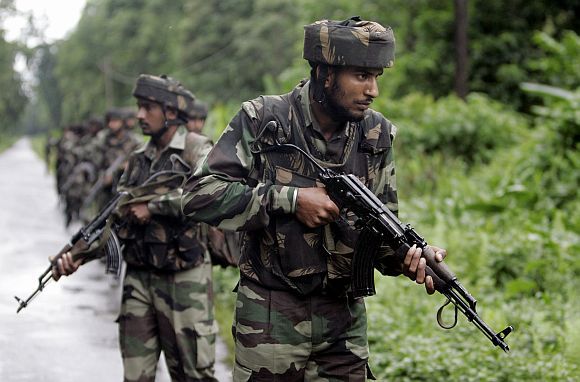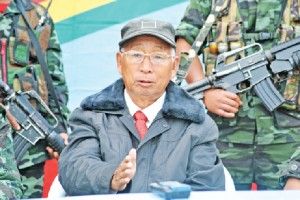 | « Back to article | Print this article |

News bulletins are rife with updates on the Manipur ambush that claimed the lives of 18 Indian soldiers.
In response to the brutal attack, the Indian Army carried out a surgical strike inside Myanmar, killing nearly 20 insurgents of the group believed to be responsible for the deadly ambush.
-- Myanmar 'hot pursuit' was planned before Manipur ambush
The Nationalist Socialist Council of Nagaland-Khaplang, led by the elusive SS Khaplang, claimed responsibility for the attack.
The NSCN-K, which reneged from a ceasefire in March, has been involved in a series of attacks in tandem with some other militant groups under the banner of the so-called United Liberation Front of South East Asia.
-- Army strikes back, guns down 20 militants behind Manipur ambush
But what exactly is the NSCN-K? Who is SS Khaplang? What are its objectives?
Rediff.com gives you a lowdown on Naga insurgency and its chief players.
What is the NSCN?
To understand the faction led by Khaplang one must understand the original composition of the NSCN that was formed on January 31, 1980 by Isak Chishi Swu, Thuingaleng Muivah and SS Khaplang.
Later, misunderstanding surfaced within the outfit leaders over the issue of commencing negotiation dialogue with the Indian Government and on April 30, 1988, the NSCN split into two factions; the NSCN-K led by S S Khaplang, and the NSCN-IM, led by Isak Chishi Swu and Thuingaleng Muivah.

Who is SS Khaplang?
NSCN-K chairman S S Khaplang is a Hemi Naga from Myanmar and is based in Myanmar, where the outfit maintains several camps. Starting 1988, the outfit has engaged in a bitter factional warfare with the NSCN-IM.
The latter, on the other hand, has described the NSCN-K as an agent of the Indian government and an ally of the security forces.
Other senior leaders including Kughalo Mulatonu are mostly based in Nagaland.
Khaplang is without a doubt one of the most influential leaders amongst the Naga militants.
Khaplang's influence was first seen when he went ahead and formed the United Liberation Front of Western South India an outfit which shelters several other North Eastern militant groups including the National Democratic Front of Bodoland-Songbijit.
Khaplang was adamant on creating his own umbrella outfit and also becomes its chairman.
What are the intentions of the NSCN and its various factions?
The NSCN is a Christian Naga nationalist militant group formed with an objective of establishing a sovereign state, “Nagalim” unifying all the areas inhabited by the Naga people in Northeast India and Burma.
The group was formed after opposition rose against the Shillong Accord signed by the then Naga National Council with the Government of India.
The current status of the group is opaque to say the least. With at least three factions all vying for the attention of the Centre the status of a ceasefire is very complicated.
What is likely to happen in the future?
Sources indicate that the NSCN-IM continues to reiterate that their demand for Naga sovereignty is "non-negotiable ".
The government opposes the idea of a "greater Nagalan" and as such the stalemate is unlikely to be resolved as it entails a re-drawing of state boundaries.
The NSCN-K, which opposed the federal governments policy of negotiating Nagaland's future only with the NSCN-IM, broke its ceasefire in March this year and finally revealed its wrath onto the 18 ambushed soliders. For the government, involving NSCN-K poses a major "acceptability"problem now, especially since Khaplang is legally a Burmese citizen.
This was not acceptable to the NSCN-IM who considered him unrepresentative of the Naga people and their aspirations.
Many observers say that the people in the North East are no longer interested in ethnic issues with the fervour with which they once did.
Peace is what they want and the recent attack seems to have negated a chance for this in the near future.